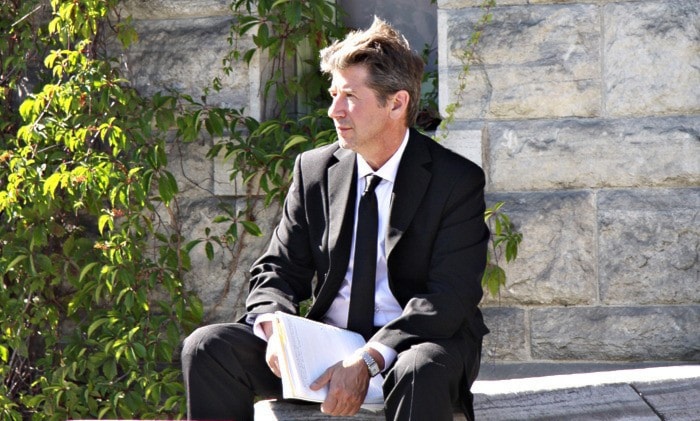Closing submissions wrapped up Thursday in the Silver Ledge Hotel arson trial, with the Crown arguing there is no other reasonable inference than Randy Hanoski deliberately set the fire that consumed the Ainsworth heritage building.
The defence countered that the Crown has failed to prove the necessary elements of the case beyond a reasonable doubt.
Nelson Provincial Court Judge Ron Fabbro will announce on December 20 when he will issue his ruling, probably sometime in January.
In her submission, Crown prosecutor Sunday Patola said Hanoski, 54, had the opportunity and motive to set the fire, which began in the trailer next to the hotel on the morning of June 3, 2010.
She said he was frustrated and angry as a result of a Supreme Court order to move out of the hotel. His former partner Cathy Brewer described him as “shell shocked” after the hearing, and quoted him as saying he no longer cared about his belongings.
Although investigators believed the fire started in the bathroom, Brewer testified it contained no flammables the last time she saw it.
Patola said the court could conclude a man seen leaving the trailer shortly after the fire began was Hanoski, even though a witness failed to identify him in a photo line-up. She said the woman’s description was otherwise consistent.
Patola also noted investigators smelled accelerant in the fire’s area of origin, even though forensic analysis did not confirm its presence.
Hanoski was a non-smoker, but a lighter was found among his effects, she pointed out. Police officers also noticed alcohol on his breath when he was arrested the next day, although no one described him as drunk.
He made “telling, spontaneous utterances” in the back of a police car en route to Trail, which were “indicative of guilt,” Patola said.
These included “I’m really upset the porch is gone, but my emotions got the better of me” and “I wanted to watch it burn. I felt very frustrated,” and “I got drunk. Then I got angry.”
“These are not the utterances of an innocent man,” Patola said.
She further noted that virtually the entire community responded to the blaze, but Hanoski was nowhere to be seen until his arrest near the scene five hours later.
“Wouldn’t a normal reaction be to help?” she asked.
Patola said the case relies heavily upon circumstantial evidence, but taken together, “the only reasonable inference is one of guilt,” and that out of “desperation and despair, [Hanoski] set fire to the property.”
Defence counsel Tyleen Underwood, however, said there was no direct evidence of the fire’s cause, although investigators concluded it was suspicious. Ultimately, she said, they were unable to determine whether it was deliberate or accidental.
Many facts they relied upon were never established in evidence, Underwood said. The onus is not on the defendant to explain the fire’s cause when the Crown hasn’t advanced one, she added.
Although investigators testified about flames first being spotted licking the trailer’s floors, she said the evidence actually suggested the first flames came from the windows.
Despite several debris samples being analyzed, no ignitable liquids or residue was detected. A petroleum distillate found on a pair of Hanoski’s boots was consistent with a footwear solution, Underwood argued.
Even if the fire was set deliberately, she said, there is no evidence Hanoski was responsible. The witness who claimed to see him leave the trailer on the morning of the fire had a limited view from 30 feet away that was obscured by smoke, and her glance only lasted a few seconds.
“There is a realistic possibility the man [she] glimpsed … was not the defendant,” she said, suggesting it was actually a local resident responding to the fire.
Underwood said police did not smell smoke or accelerant on Hanoski.
As for the statements in the police car, she told the judge the first two were consistent with someone frustrated at watching their property burn, but did not claim responsibility. She said the final statement did not reference the fire or property, was “vague and ambiguous,” and absent any context, couldn’t be considered evidence.
She also took issue with the lighter allegedly found among Hanoski’s effects, saying relevant evidence would have been immediately seized and documented, but in fact the lighter only turned up several days later.
“There is no credible evidence the lighter was in his possession prior to his arrest,” she said.
Underwood also doubted Hanoski had a strong motive, since as co-owner of the property he suffered from the buildings’ loss, neither of which was insured.
The Crown opted not to call any additional witnesses before closing arguments, while the defence called no evidence.
The trial began in September.
